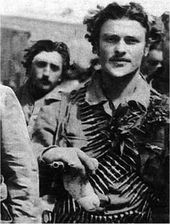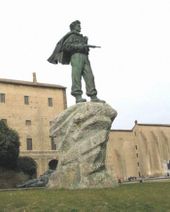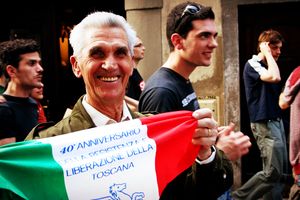حركة المقاومة الإيطالية
| حركة المقاومة الإيطالية | |
|---|---|
| مشارك في the Italian Civil War and World War II | |
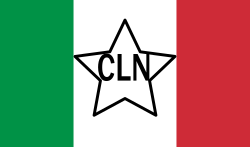 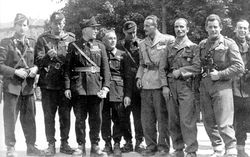 Flag of the National Liberation Committee and some members of the Italian resistance in Ossola, 1944. | |
| فترة النشاط | Most active 1943–1945; however, the Resistance actually originated following the rise of Fascist Italy in the 1920s |
| الأيديولوجية | Various: Generally Anti-fascism; Mainly various forms of communism, socialism, and anarchism; Republicanism and liberalism To a lesser extent: Liberal socialism Christian democracy Catholic anti-fascism/Catholic anti-Nazism and Catholic socialism Social liberalism Social democracy Monarchism |
| الحلفاء | Allied powers |
| الخصوم | Axis powers (Nazi Germany and Italian Social Republic) |
حركة المقاومة الإيطالية (إيطالية: Resistenza italiana or just la Resistenza) is an umbrella term for Italian resistance groups during World War II. It was opposed to the forces of Nazi Germany as well as their puppet state local regime, the Italian Social Republic, especially following the German military occupation of Italy between September 1943 and April 1945, though the resistance to the Fascist Italian government began even prior to World War II. The movement that rose among Italians of various social classes is also known as the Italian resistance and the Italian partisans (partigiani in Italian), and the brutal conflict they took part in is referred to as the Italian Liberation War (when referring to the part they took in the Italian Campaign against the Axis) or as the Italian Civil War (when referring specifically to the conflict with Italian Fascists). The modern Italian Republic was declared to be founded on the struggle of the Resistance.
. . . . . . . . . . . . . . . . . . . . . . . . . . . . . . . . . . . . . . . . . . . . . . . . . . . . . . . . . . . . . . . . . . . . . . . . . . . . . . . . . . . . . . . . . . . . . . . . . . . . . . . . . . . . . . . . . . . . . . . . . . . . . . . . . . . . . . . . . . . . . . . . . . . . . . . . . . . . . . . . . . . . . . . .
المقاومة من القوات المسلحة الإيطالية
في إيطاليا
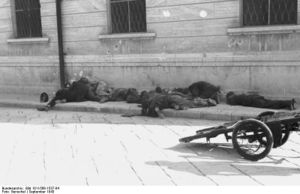
حركة الپارتيزان
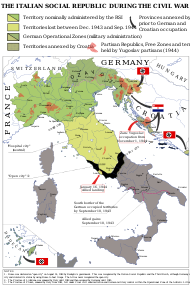
Rodolfo Graziani estimated the partisan strength at around 70,000-80,000 by May 1944.[1] Some 41% in the Garibaldi Brigades and 29% were Actionists of the Giustizia e Libertà Brigades.[2] One of the strongest units, the 8th Garibaldi Brigade, had 8,050 men (450 without arms) and operated in the Romagna area.[1]
الريف
الپارتيزان النساء

انتفاضة 1944
إمرأة أُعدِمت شنقاً على الملأ في أحد شوارع روما، بمطلع 1944
Three Italian partisans executed by public hanging في ريميني, August 1944
German soldier examining the papers of an Italian civilian خارج ميلانو (1944)
The Sant'Anna di Stazzema massacre memorial relief
حجر تذكاري في سورانيا لإثنين من الپارتيزان الإيطاليين – قـُتـِلا في 1944
المساهمات الأجنبية
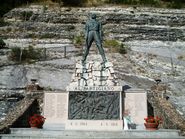
التحرير
انتفاضة 1945
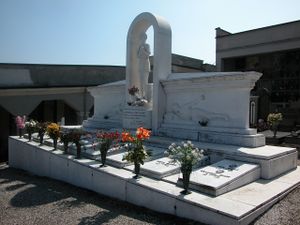
On April 19, 1945, the CLN called for an insurrection (the April 25 uprising). Bologna was attacked by partisans on April 19 and was liberated on April 21 by the Italian Co-Belligerent Army and the Polish II Corps under Allied command; Parma and Reggio Emilia were freed on April 24.
القتل الانتقامي

. . . . . . . . . . . . . . . . . . . . . . . . . . . . . . . . . . . . . . . . . . . . . . . . . . . . . . . . . . . . . . . . . . . . . . . . . . . . . . . . . . . . . . . . . . . . . . . . . . . . . . . . . . . . . . . . . . . . . . . . . . . . . . . . . . . . . . . . . . . . . . . . . . . . . . . . . . . . . . . . . . . . . . . .
يوم التحرير
Since 1949, April 25 has been officially celebrated as Liberation Day, also known as Anniversary of the Resistance. Speaking at the 2014 anniversary, President Giorgio Napolitano said: "The values and merits of the Resistance, from the Partisan movement and the soldiers who sided with the fight for liberation to the Italian armed forces, are indelible and beyond any rhetoric of mythicization or any biased denigration. The Resistance, the commitment to reconquer Italy's liberty and independence, was a great civil engine of ideals, but above all it was a people in arms, a courageous mobilization of young and very young citizens who rebelled against foreign power."[3]
انظر أيضاً
- Anti-fascism
- ANPI, an association of the participants to the Italian resistance
- Volante Rossa an Italian communist antifascist militia active after WWII
- People's Squads, an Italian left-wing antifascist militia active during the early 1920s
- "Bella Ciao", anthem of the anti-fascist resistance
- Mazzini Society, formed by expatriate Italian anti-Fascists in the United States
- Anni di piombo
- Anarchism in Italy
- German Resistance to Nazism
- Japanese dissidence during the Showa period
- Museum of the Liberation of Rome
In works of popular culture
- The Abandoned
- Achtung! Banditi!
- Bebo's Girl
- Blood of the Losers
- Captain Corelli's Mandolin
- Cloak and Dagger
- Cloak & Dagger
- A Day for Lionhearts
- A Day in Life
- The Dirty Dozen: The Deadly Mission
- Escape by Night
- Everybody Go Home
- The Fall of Italy
- The Fallen
- The Fascist
- The Four Days of Naples
- From the Clouds to the Resistance
- General della Rovere
- His Day of Glory
- Hornets' Nest
- The Hunchback of Rome
- Johnny the Partisan
- Last Days of Mussolini
- Little Teachers
- Long Night in 1943
- The Man Who Will Come
- Massacre in Rome
- The Mattei Affair
- Miracle at St. Anna
- Outcry
- Paisan
- The Path to the Nest of Spiders
- Porzûs
- Rome, Open City
- The Seven Cervi Brothers
- Ten Italians for One German
- Two Anonymous Letters
References
- ^ أ ب Moseley, Roger (2004). Mussolini: The Last 600 Days of Il Duce. Taylor Trade Publishing.
{{cite book}}: CS1 maint: location missing publisher (link) - ^ Longhi, Silvano (2010). Die Juden und der Widerstand gegen den Faschismus in Italien: 1943 - 1945. Berlin.
{{cite book}}: CS1 maint: location missing publisher (link) - ^ "Italy celebrates Liberation Day - Politics - ANSAMed.it". Ansamed.info. 1944-06-04. Retrieved 2014-05-19.
وصلات خارجية
- Italy | European Resistance Archive
- (Italian) ANPI – Associazione Nazionale Partigiani d'Italia
- (Italian) ANCFARGL – Associazione Nazionale Combattenti Forze Armate Regolari Guerra di Liberazione
- (Italian) INSMLI – Istituto Nazionale per la Storia del Movimento di Liberazione in Italia
- (Italian) Il portale della guerra di Liberazione
- Anarchist partisans in the Italian Resistance
- CS1 maint: location missing publisher
- Short description is different from Wikidata
- Articles containing إيطالية-language text
- Pages using Lang-xx templates
- Articles with hatnote templates targeting a nonexistent page
- مناهضة الفاشية في إيطاليا
- المقاومة الإيطالية
- التاريخ الحديث لإيطاليا
- World War II resistance movements

